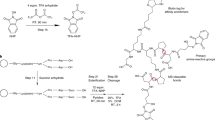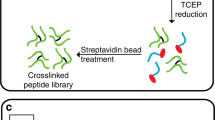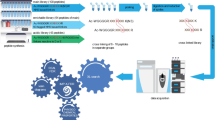Abstract
Chemical cross-linking in combination with mass spectrometry generates distance restraints of amino acid pairs in close proximity on the surface of native proteins and protein complexes. In this study we used quantitative mass spectrometry and chemical cross-linking to quantify differences in cross-linked peptides obtained from complexes in spatially discrete states. We describe a generic computational pipeline for quantitative cross-linking mass spectrometry consisting of modules for quantitative data extraction and statistical assessment of the obtained results. We used the method to detect conformational changes in two model systems: firefly luciferase and the bovine TRiC complex. Our method discovers and explains the structural heterogeneity of protein complexes using only sparse structural information.
This is a preview of subscription content, access via your institution
Access options
Subscribe to this journal
Receive 12 print issues and online access
$259.00 per year
only $21.58 per issue
Buy this article
- Purchase on Springer Link
- Instant access to full article PDF
Prices may be subject to local taxes which are calculated during checkout




Similar content being viewed by others
References
Leitner, A. et al. Probing native protein structures by chemical cross-linking, mass spectrometry, and bioinformatics. Mol. Cell. Proteomics 9, 1634–1649 (2010).
Rappsilber, J. The beginning of a beautiful friendship: cross-linking/mass spectrometry and modelling of proteins and multi-protein complexes. J. Struct. Biol. 173, 530–540 (2011).
Walzthoeni, T. et al. False discovery rate estimation for cross-linked peptides identified by mass spectrometry. Nat. Methods 9, 901–903 (2012).
Mayne, S.L.N. & Patterton, H.G. Bioinformatics tools for the structural elucidation of multi-subunit protein complexes by mass spectrometric analysis of protein-protein cross-links. Brief. Bioinform. 12, 660–671 (2011).
Trnka, M.J., Baker, P.R., Robinson, P.J., Burlingame, A.L. & Chalkley, R.J. Matching cross-linked peptide spectra: only as good as the worse identification. Mol. Cell. Proteomics 13, 420–434 (2014).
Yang, B. et al. Identification of cross-linked peptides from complex samples. Nat. Methods 9, 904–906 (2012).
Rinner, O. et al. Identification of cross-linked peptides from large sequence databases. Nat. Methods 5, 315–318 (2008).
Politis, A. et al. A mass spectrometry–based hybrid method for structural modeling of protein complexes. Nat. Methods 11, 403–406 (2014).
Young, M.M. et al. High throughput protein fold identification by using experimental constraints derived from intramolecular cross-links and mass spectrometry. Proc. Natl. Acad. Sci. USA 97, 5802–5806 (2000).
Lasker, K. et al. Molecular architecture of the 26S proteasome holocomplex determined by an integrative approach. Proc. Natl. Acad. Sci. USA 109, 1380–1387 (2012).
Leitner, A. et al. The molecular architecture of the eukaryotic chaperonin TRiC/CCT. Structure 20, 814–825 (2012).
Bui, K.H. et al. Integrated structural analysis of the human nuclear pore complex scaffold. Cell 155, 1233–1243 (2013).
Greber, B.J. et al. Architecture of the large subunit of the mammalian mitochondrial ribosome. Nature 505, 515–519 (2014).
Herzog, F. et al. Structural probing of a protein phosphatase 2A network by chemical cross-linking and mass spectrometry. Science 337, 1348–1352 (2012).
Tosi, A. et al. Structure and subunit topology of the INO80 chromatin remodeler and its nucleosome complex. Cell 154, 1207–1219 (2013).
Joachimiak, L.A., Walzthoeni, T., Liu, C.W., Aebersold, R. & Frydman, J. The structural basis of substrate recognition by the eukaryotic chaperonin TRiC/CCT. Cell 159, 1042–1055 (2014).
Schmidt, C. et al. Comparative cross-linking and mass spectrometry of an intact F-type ATPase suggest a role for phosphorylation. Nat. Commun. 4, 1985 (2013).
Fischer, L., Chen, Z.A. & Rappsilber, J. Quantitative cross-linking/mass spectrometry using isotope-labelled cross-linkers. J. Proteomics 88, 120–128 (2013).
Schmidt, C. & Robinson, C.V. A comparative cross-linking strategy to probe conformational changes in protein complexes. Nat. Protoc. 9, 2224–2236 (2014).
Cappadona, S., Baker, P.R., Cutillas, P.R., Heck, A.J. & van Breukelen, B. Current challenges in software solutions for mass spectrometry-based quantitative proteomics. Amino Acids 43, 1087–1108 (2012).
Mueller, L.N. et al. SuperHirn—a novel tool for high resolution LC-MS-based peptide/protein profiling. Proteomics 7, 3470–3480 (2007).
Sturm, M. et al. OpenMS—an open-source software framework for mass spectrometry. BMC Bioinformatics 9, 163 (2008).
Cox, J. & Mann, M. MaxQuant enables high peptide identification rates, individualized p.p.b.-range mass accuracies and proteome-wide protein quantification. Nat. Biotechnol. 26, 1367–1372 (2008).
Leitner, A. et al. Expanding the chemical cross-linking toolbox by the use of multiple proteases and enrichment by size exclusion chromatography. Mol. Cell. Proteomics 11 M111.014126 (2012).
Reiter, L. et al. mProphet: automated data processing and statistical validation for large-scale SRM experiments. Nat. Methods 8, 430–435 (2011).
Nakatsu, T. et al. Structural basis for the spectral difference in luciferase bioluminescence. Nature 440, 372–376 (2006).
Conti, E., Franks, N.P. & Brick, P. Crystal structure of firefly luciferase throws light on a superfamily of adenylate-forming enzymes. Structure 4, 287–298 (1996).
Sundlov, J.A., Fontaine, D.M., Southworth, T.L., Branchini, B.R. & Gulick, A.M. Crystal structure of firefly luciferase in a second catalytic conformation supports a domain alternation mechanism. Biochemistry 51, 6493–6495 (2012).
Kahraman, A. et al. Cross-link guided molecular modeling with ROSETTA. PLoS One 8, e73411 (2013).
Brovko, L.I., Beliaeva, E.I. & Ugarova, N.N. Subunit interactions in luciferase from the firefly Luciola mingrelica. Their role in the manifestation of enzyme activity and during thermoinactivation. Biokhimiia 47, 760–766 (1982).
Gray, J.J. et al. Protein-protein docking with simultaneous optimization of rigid-body displacement and side-chain conformations. J. Mol. Biol. 331, 281–299 (2003).
Bigotti, M.G. & Clarke, A.R. Chaperonins: the hunt for the Group II mechanism. Arch. Biochem. Biophys. 474, 331–339 (2008).
Bigotti, M.G., Bellamy, S.R. & Clarke, A.R. The asymmetric ATPase cycle of the thermosome: elucidation of the binding, hydrolysis and product-release steps. J. Mol. Biol. 362, 835–843 (2006).
Hartl, F.U., Bracher, A. & Hayer-Hartl, M. Molecular chaperones in protein folding and proteostasis. Nature 475, 324–332 (2011).
Horwich, A.L., Fenton, W.A., Chapman, E. & Farr, G.W. Two families of chaperonin: physiology and mechanism. Annu. Rev. Cell Dev. Biol. 23, 115–145 (2007).
Spiess, C., Meyer, A.S., Reissmann, S. & Frydman, J. Mechanism of the eukaryotic chaperonin: protein folding in the chamber of secrets. Trends Cell Biol. 14, 598–604 (2004).
Reissmann, S. et al. A gradient of ATP affinities generates an asymmetric power stroke driving the chaperonin TRIC/CCT folding cycle. Cell Rep. 2, 866–877 (2012).
Meyer, A.S. et al. Closing the folding chamber of the eukaryotic chaperonin requires the transition state of ATP hydrolysis. Cell 113, 369–381 (2003).
Reissmann, S., Parnot, C., Booth, C.R., Chiu, W. & Frydman, J. Essential function of the built-in lid in the allosteric regulation of eukaryotic and archaeal chaperonins. Nat. Struct. Mol. Biol. 14, 432–440 (2007).
Cong, Y. et al. Symmetry-free cryo-EM structures of the chaperonin TRiC along its ATPase-driven conformational cycle. EMBO J. 31, 720–730 (2012).
Leitner, A., Walzthoeni, T. & Aebersold, R. Lysine-specific chemical cross-linking of protein complexes and identification of cross-linking sites using LC-MS/MS and the xQuest/xProphet software pipeline. Nat. Protoc. 9, 120–137 (2014).
Chambers, M.C. et al. A cross-platform toolkit for mass spectrometry and proteomics. Nat. Biotechnol. 30, 918–920 (2012).
Fisher, R.A. Statistical Methods for Research Workers (Oliver and Boyd, 1925).
Benjamini, Y. & Hochberg, Y. Controlling the false discovery rate: a practical and powerful approach to multiple testing. J. R. Stat. Soc. Series. B Stat. Methodol. 57, 289–300 (1995).
Toprak, U.H. et al. Conserved peptide fragmentation as a benchmarking tool for mass spectrometers and a discriminating feature for targeted proteomics. Mol. Cell. Proteomics 13, 2056–2071 (2014).
Noble, W.S. How does multiple testing correction work? Nat. Biotechnol. 27, 1135–1137 (2009).
Bernstein, F.C. et al. The Protein Data Bank: a computer-based archival file for macromolecular structures. J. Mol. Biol. 112, 535–542 (1977).
Leaver-Fay, A. et al. Scientific benchmarks for guiding macromolecular energy function improvement. Methods Enzymol. 523, 109–143 (2013).
Leitner, A. et al. Chemical cross-linking/mass spectrometry targeting acidic residues in proteins and protein complexes. Proc. Natl. Acad. Sci. USA 111, 9455–9460 (2014).
Acknowledgements
This work was supported by the European Union 7th Framework project PROSPECTS (Proteomics Specification in Time and Space; grant HEALTH-F4-2008-201648). R.A. is supported by European Research Council (ERC) advanced grant “Proteomics v.3.0” (grant 233226), ERC advanced grant “Proteomics 4D—the proteome in context” (grant 670821) and ETH Zurich. We thank M. Beck (EMBL Heidelberg) for helpful discussions.
Author information
Authors and Affiliations
Contributions
T.W. performed cross-linking experiments, analyzed the data and wrote the software. L.A.J. analyzed data. G.R. and L.M. performed the docking analysis. H.L.R. and G.R. provided input for using mProphet. A.L. provided MS instrument support. J.F. and L.A.J. provided the TRiC samples. T.W., L.A.J., A.L. and R.A. designed the experiments. All authors contributed to the manuscript.
Corresponding author
Ethics declarations
Competing interests
The authors declare no competing financial interests.
Integrated supplementary information
Supplementary Figure 1 Targeted extraction and statistical validation of ion chromatograms (TeXaS).
(a) Workflow of the TeXaS algorithms developed to quantify and validate ion chromatograms from cross-linked peptides from data dependent analysis MS experiments. (b) Model of an extracted ion chromatogram of a cross-linked peptide ion showing the extracted ion chromatograms of the individual isotopes. (c) Statistics on all extracted ion chromatogram peak groups generated by mProphet. (d) Sensitivity and q-value vs. the normalized discriminant score. (e) Sensitivity and q-value. The data point at which the sensitivity reaches its maximum is indicated by the dot. This corresponds to the maximal q-value that is used to further process the peak groups.
Supplementary Figure 2 Overlap of cross-linked peptides between different workflows of the dilution series dataset of model proteins.
In total 179 unique cross-linked peptides were identified across both experiments, 121 cross-linked peptides were in common between the differential isotopic label workflow and the LFQ-like workflow, 148 cross-links were identified by the LFQ-like workflow and 152 by the differential isotopic label workflow. The cross-links were validated using xProphet with an FDR cutoff of 5%.
Supplementary Figure 3 Histogram of measured Cα distances of cross-links from the dilution series dataset.
Validation of the cross-links from the dilution series dataset of model proteins on the available protein structures or homology models of BSA, transferrin and conalbumin (see also Online methods). Out of 270 cross-links that were mapped onto the structures from the different workflows 12 cross-links exceeded the distance threshold of 32 Å (blue). This corresponds to 4.4% of all validated cross-links and is in good agreement with the selected FDR cutoff of 5%.
Supplementary Figure 4 Quantification results from the dilution series benchmarking dataset.
Shown are box plots and individual data points of the different cross-links from the different proteins that were mixed in defined ratios. The figure is divided into three columns (corresponding to the different workflows and the LFQ-like workflow when using only light cross-links) and three rows corresponding to the different dilutions (Samples 2-4) as outlined in Supplementary Table 1. The horizontal dotted lines indicate the expected values for the individual proteins. Bars within the box plot indicate the median values. Upper and lower hinges correspond to the first and third quartiles, whiskers correspond to +/- 1.5x the inter-quartile range.
Supplementary Figure 5 Luminescence measurements during the cross-linking reaction of luciferase.
Shown is the decrease in luminescence during the cross-linking reaction (green line, +XL) compared to the positive control (blue line, -XL), both in presence of luciferin (LUC) and ATP. The yellow line shows the negative control (no luciferin and ATP). Data presented as mean ± s.d.
Supplementary Figure 6 Quantitative analysis of cross-links from the luciferase dataset.
(a) Volcano plot from the differential isotopic label workflow. (b) Volcano plot from the LFQ-like workflow. In the volcano plots the log2 ratios are plotted against the adjusted negative log10 P values. Indicated by color is if the observed changes are significant (blue) or not (red) (adjusted P value < 0.01 and absolute log2 fold change >1). The log2 ratios are shown with the apo experiment used as reference.
Supplementary Figure 7 Luciferase control experiments.
Shown in figure (a) and (b) are the log2 fold changes and negative log10 P values of the cross-links for the LFQ-like experiment by comparing different biochemical replicates against each other. Figure (c) shows the log2 fold changes of the cross-links for the Master Mix experiment, where light label is compared to the heavy labeled sample. Indicated by color is if the observed changes are significant (blue) or not (red) (adjusted P value < 0.01 and absolute log2 fold change >1).
Supplementary Figure 8 Docking analysis and structural models of luciferase.
(a) Docking analysis, shown are the Rosetta energy score and the number of satisfied restraints for the models generated by the docking analysis, (b) Manual solution of the luciferase dimer, (c) Best (highest number of satisfied restraints) docking model of the luciferase dimer, (d) Dimer model of luciferase in the alternative conformation where luciferase is bound to the nucleotide analog DLSA (based on PDB ID 4G36) (e) Dimer model of luciferase in the alternative conformation where luciferase was stalled in a secondary conformation using a cysteine cross-linking approach (based on PDB ID 4G37).
Supplementary Figure 9 Quantitative changes measured by qCX-MS on luciferase.
(a) Quantitative differences and Euclidean distances (Å) comparing apo (PDB ID 1LCI) to the alternative conformation of luciferase (PDB ID 4G36). (b) shows the comparison of apo (PDB ID 1LCI) to the secondary conformation described by the PDB ID 4G37. 2 FP cross-links exceeding the distance threshold of the cross-linker on both models are not shown. Colors red and blue indicate significantly changed uxIDs (adjusted P value <0.01 and absolute log2 fold change >1).
Supplementary Figure 10 Proposed network effect model explaining the quantitative behavior of the indicated cross-links.
(a) and (b): Stereo view of the active site of luciferase with bound DLSA in two different conformations (PDB ID 4G36 and 4G37). The residues Lys529 and Lys443 which contact the substrate are indicated by arrows. Adapted with permission from Sundlov, J. A., Fontaine, D. M., Southworth, T. L., Branchini, B. R. & Gulick, A. M. (2012). Biochemistry 51, 6493-6495. Copyright 2012 American Chemical Society. (c) Proposed model suggesting that inhibition of the formation of the cross-link between Lys142 and Lys529, which is blocked by the substrate binding, leads to the dominant cross-link 142-541 which shows a twofold increase in the second conformation. At the same time the cross-links 142-380 and 142-329 show a decreased abundance in the second confirmation presumably due to the dominant cross-link 142-541 and structural rearrangements.
Supplementary Figure 11 Correlation and volcano plots of the TRiC apo and ATP-AlFx datasets using different quantitative cross-linking workflows.
(a) Correlation of common data points between the LFQ-like workflow and the differential isotopic label workflow. (b) Volcano plot of the LFQ-like workflow. (c) Volcano plot of the differential isotopic label workflow. In the volcano plots the log2 ratios are plotted against the adjusted negative log10 P values. Indicated by color is if the observed changes are significant (blue) or not (red) (adjusted P value < 0.01 and absolute log2 fold change >1). The log2 ratios are shown with the apo experiment used as reference.
Supplementary Figure 12 Volcano plots of the TRiC transition states.
(a–e) Volcano plots of the different TRiC transition states compared against the apo state (LFQ-like workflow). Shown are the log2 ratios plotted against the adjusted negative log10 P values. Indicated by color is if the observed changes are significant (blue) or not (red) (adjusted P value < 0.01 and absolute log2 fold change >1).
Supplementary information
Supplementary Text and Figures
Supplementary Figures 1–12, Supplementary Table 1 and 9, Supplementary Results 1–3, and Supplementary Note 1 (PDF 1876 kb)
Supplementary Table 2
Cross-link identifications from the dilution series dataset. (XLSX 39 kb)
Supplementary Table 3
Quantification results from the dilution series dataset. (XLSX 42 kb)
Supplementary Table 4
Cross-link identifications from the luciferase experiment (LFQ-like workflow). (XLSX 20 kb)
Supplementary Table 5
Cross-link identifications from the luciferase experiment (Differential label workflow). (XLSX 17 kb)
Supplementary Table 6
Combined quantification results of the luciferase dataset. (XLSX 17 kb)
Supplementary Table 7
Cross-link identifications from the TRiC dataset. (XLSX 137 kb)
Supplementary Table 8
Quantification results from the TRiC dataset (LFQ-like workflow). (XLSX 103 kb)
Supplementary Table 10
Main standard parameters used for XIC extraction by xtract.pl (XLSX 11 kb)
Supplementary Software
xTract software tool. Detailed installation, usage instructions and updates can be found at http://proteomics.ethz.ch. (ZIP 375 kb)
Rights and permissions
About this article
Cite this article
Walzthoeni, T., Joachimiak, L., Rosenberger, G. et al. xTract: software for characterizing conformational changes of protein complexes by quantitative cross-linking mass spectrometry. Nat Methods 12, 1185–1190 (2015). https://doi.org/10.1038/nmeth.3631
Received:
Accepted:
Published:
Issue Date:
DOI: https://doi.org/10.1038/nmeth.3631
This article is cited by
-
Characterization of protein unfolding by fast cross-linking mass spectrometry using di-ortho-phthalaldehyde cross-linkers
Nature Communications (2022)
-
A chemical probe based on the PreQ1 metabolite enables transcriptome-wide mapping of binding sites
Nature Communications (2021)
-
Proper evaluation of chemical cross-linking-based spatial restraints improves the precision of modeling homo-oligomeric protein complexes
BMC Bioinformatics (2019)
-
Quantitative cross-linking/mass spectrometry to elucidate structural changes in proteins and their complexes
Nature Protocols (2019)
-
The ubiquitin-like modifier FAT10 interferes with SUMO activation
Nature Communications (2019)



